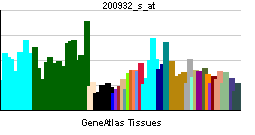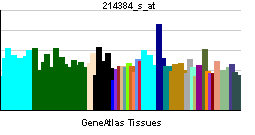DCTN2
| Dynactin 2 (p50) | |||||||||||
|---|---|---|---|---|---|---|---|---|---|---|---|
| Identifiers | |||||||||||
| Symbols | DCTN2 ; DCTN50; DYNAMITIN; RBP50 | ||||||||||
| External IDs | Template:OMIM5 Template:MGI HomoloGene: 4667 | ||||||||||
| |||||||||||
| RNA expression pattern | |||||||||||
 | |||||||||||
 | |||||||||||
| More reference expression data | |||||||||||
| Orthologs | |||||||||||
| Template:GNF Ortholog box | |||||||||||
| Species | Human | Mouse | |||||||||
| Entrez | n/a | n/a | |||||||||
| Ensembl | n/a | n/a | |||||||||
| UniProt | n/a | n/a | |||||||||
| RefSeq (mRNA) | n/a | n/a | |||||||||
| RefSeq (protein) | n/a | n/a | |||||||||
| Location (UCSC) | n/a | n/a | |||||||||
| PubMed search | n/a | n/a | |||||||||
Dynactin 2 (p50), also known as DCTN2, is a human gene.[1]
This gene encodes a 50-kD subunit of dynactin, a macromolecular complex consisting of 10-11 subunits ranging in size from 22 to 150 kD. Dynactin binds to both microtubules and cytoplasmic dynein. It is involved in a diverse array of cellular functions, including ER-to-Golgi transport, the centripetal movement of lysosomes and endosomes, spindle formation, chromosome movement, nuclear positioning, and axonogenesis. This subunit is present in 4-5 copies per dynactin molecule. It contains three short alpha-helical coiled-coil domains that may mediate association with self or other dynactin subunits. It may interact directly with the largest subunit (p150) of dynactin and may affix p150 in place.[1]
References
Further reading
- Maruyama K, Sugano S (1994). "Oligo-capping: a simple method to replace the cap structure of eukaryotic mRNAs with oligoribonucleotides". Gene. 138 (1–2): 171–4. PMID 8125298.
- Echeverri CJ, Paschal BM, Vaughan KT, Vallee RB (1996). "Molecular characterization of the 50-kD subunit of dynactin reveals function for the complex in chromosome alignment and spindle organization during mitosis". J. Cell Biol. 132 (4): 617–33. PMID 8647893.
- Suzuki Y, Yoshitomo-Nakagawa K, Maruyama K; et al. (1997). "Construction and characterization of a full length-enriched and a 5'-end-enriched cDNA library". Gene. 200 (1–2): 149–56. PMID 9373149.
- Starr DA, Williams BC, Hays TS, Goldberg ML (1998). "ZW10 helps recruit dynactin and dynein to the kinetochore". J. Cell Biol. 142 (3): 763–74. PMID 9700164.
- Berrueta L, Tirnauer JS, Schuyler SC; et al. (1999). "The APC-associated protein EB1 associates with components of the dynactin complex and cytoplasmic dynein intermediate chain". Curr. Biol. 9 (8): 425–8. PMID 10226031.
- Eckley DM, Gill SR, Melkonian KA; et al. (1999). "Analysis of dynactin subcomplexes reveals a novel actin-related protein associated with the arp1 minifilament pointed end". J. Cell Biol. 147 (2): 307–20. PMID 10525537.
- Karki S, Tokito MK, Holzbaur EL (2000). "A dynactin subunit with a highly conserved cysteine-rich motif interacts directly with Arp1". J. Biol. Chem. 275 (7): 4834–9. PMID 10671518.
- Merdes A, Heald R, Samejima K; et al. (2000). "Formation of spindle poles by dynein/dynactin-dependent transport of NuMA". J. Cell Biol. 149 (4): 851–62. PMID 10811826.
- Yue L, Lu S, Garces J; et al. (2000). "Protein kinase C-regulated dynamitin-macrophage-enriched myristoylated alanine-rice C kinase substrate interaction is involved in macrophage cell spreading". J. Biol. Chem. 275 (31): 23948–56. doi:10.1074/jbc.M001845200. PMID 10827182.
- Vancoillie G, Lambert J, Haeghen YV; et al. (2001). "Colocalization of dynactin subunits P150Glued and P50 with melanosomes in normal human melanocytes". Pigment Cell Res. 13 (6): 449–57. PMID 11153697.
- Hoogenraad CC, Akhmanova A, Howell SA; et al. (2001). "Mammalian Golgi-associated Bicaudal-D2 functions in the dynein-dynactin pathway by interacting with these complexes". EMBO J. 20 (15): 4041–54. doi:10.1093/emboj/20.15.4041. PMID 11483508.
- Short B, Preisinger C, Schaletzky J; et al. (2003). "The Rab6 GTPase regulates recruitment of the dynactin complex to Golgi membranes". Curr. Biol. 12 (20): 1792–5. PMID 12401177.
- Strausberg RL, Feingold EA, Grouse LH; et al. (2003). "Generation and initial analysis of more than 15,000 full-length human and mouse cDNA sequences". Proc. Natl. Acad. Sci. U.S.A. 99 (26): 16899–903. doi:10.1073/pnas.242603899. PMID 12477932.
- Gevaert K, Goethals M, Martens L; et al. (2004). "Exploring proteomes and analyzing protein processing by mass spectrometric identification of sorted N-terminal peptides". Nat. Biotechnol. 21 (5): 566–9. doi:10.1038/nbt810. PMID 12665801.
- Ota T, Suzuki Y, Nishikawa T; et al. (2004). "Complete sequencing and characterization of 21,243 full-length human cDNAs". Nat. Genet. 36 (1): 40–5. doi:10.1038/ng1285. PMID 14702039.
- Uetake Y, Terada Y, Matuliene J, Kuriyama R (2004). "Interaction of Cep135 with a p50 dynactin subunit in mammalian centrosomes". Cell Motil. Cytoskeleton. 58 (1): 53–66. doi:10.1002/cm.10175. PMID 14983524.
- Brill LM, Salomon AR, Ficarro SB; et al. (2004). "Robust phosphoproteomic profiling of tyrosine phosphorylation sites from human T cells using immobilized metal affinity chromatography and tandem mass spectrometry". Anal. Chem. 76 (10): 2763–72. doi:10.1021/ac035352d. PMID 15144186.
- Ballif BA, Villén J, Beausoleil SA; et al. (2005). "Phosphoproteomic analysis of the developing mouse brain". Mol. Cell Proteomics. 3 (11): 1093–101. doi:10.1074/mcp.M400085-MCP200. PMID 15345747.
- Gerhard DS, Wagner L, Feingold EA; et al. (2004). "The status, quality, and expansion of the NIH full-length cDNA project: the Mammalian Gene Collection (MGC)". Genome Res. 14 (10B): 2121–7. doi:10.1101/gr.2596504. PMID 15489334.
- Ficarro SB, Salomon AR, Brill LM; et al. (2005). "Automated immobilized metal affinity chromatography/nano-liquid chromatography/electrospray ionization mass spectrometry platform for profiling protein phosphorylation sites". Rapid Commun. Mass Spectrom. 19 (1): 57–71. doi:10.1002/rcm.1746. PMID 15570572.
| This protein-related article is a stub. You can help Wikipedia by expanding it. |